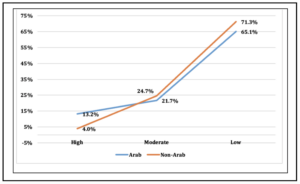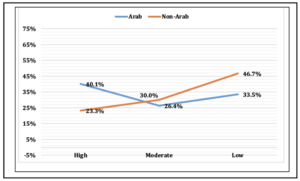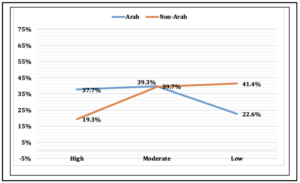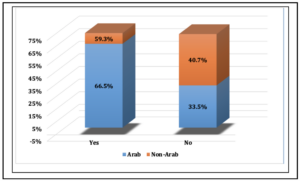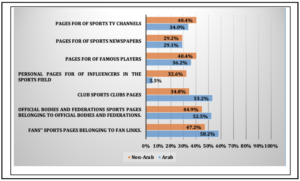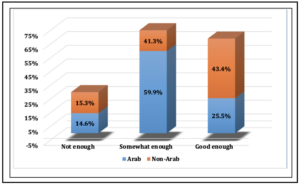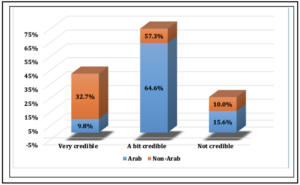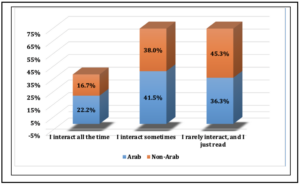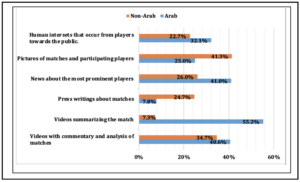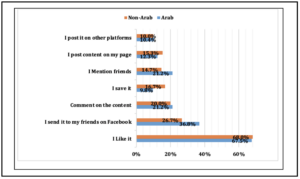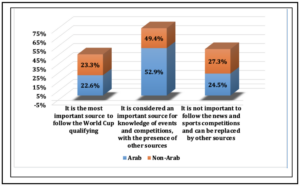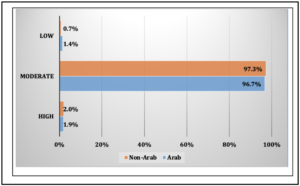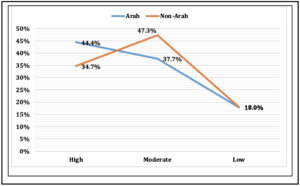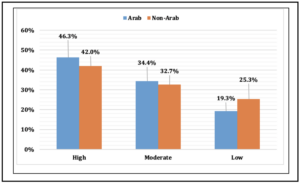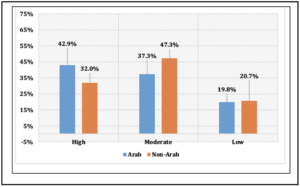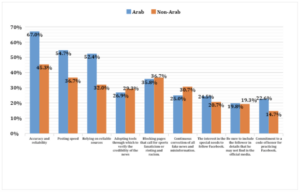Issue 33, winter/spring 2022
https://doi.org/10.70090/HSDS22WC
Abstract
Over the past decade, sports teams and federations have prioritized providing content on important digital platforms to circulate relevant news and coverage, particularly on social networking sites. These sites have increasingly become reliable news sources that audiences can follow and then share this content among themselves. With the Middle East taking the global stage for the first time as the host of this event, it is useful to understand the similarities and differences between Arab and non-Arab audiences’ use of social media during the tournament’s qualifying stages. As such, this study compares Arab and non-Arab audiences’ use of Facebook as an information source for the 2022 World Cup qualifying matches. Results indicate that Facebook continues to enjoy a good relationship with its users who are motivated by amusement and entertainment (Ordinary) while seeking to obtain information and communicate with other individuals (Utilitarian). While these findings reflect and refine the five motivations posited by Haugh and Watkins (2016), this study also demonstrates that motives for new media require more depth and nuance than allowed for with the binary “Ordinary” and “Utilitarian” categorizations. This has implications for the Uses and Gratifications Theory as well as the methods used to study it.
Introduction
Until the mid-1990s, sports fans followed the progress of their favorite sports entities by reading the newspaper’s sports section, listening to sports-talk radio, or watching the sports program. Today, sports fans are more interested in following up on news of their favorite sport by watching live streams of sports events online, and engaging sports organizations, teams, and other sports via social networking sites (Pedersen 2017).
Audiences have become fragmented across streaming platforms and digital spaces, watching what they want, when they want. These shifts in viewing habits and preferences have been exacerbated by the emergence of social networking sites, which brought about new patterns of follow-up for different events, activities, hobbies, the spread of news, and the exchange of opinions (Mauro 2020).
While new social and digital platforms have emerged, Facebook maintains the leading position in public adoption and use. According to the Internet and American Life Project report by Pew Research Centre, about a third of U.S. adults (31%) say they get news regularly on Facebook (Matsa 2021). The Arab Social Media Report series produced by the Dubai School of Government's Governance and Innovation Program is a recurring study that explores the number of Facebook users in the Arab world. According to the report, usage has increased by 30% in the first quarter of 2017 (Arab Social Media 2017). Several studies indicated that Facebook users’ favorite content is sports news because they can access unlimited information about their favorite sports, teams, and athletes, and they can interact with other fans from around the world (Lacy 2014; Pedersen 2017). This is often credited to audience gratification, including sporting events and competitions. This holds particularly true for football (soccer). Football's popularity means its premier event—the World Cup—is one of the world's most eminent and lucrative sporting mega-events. Since the tournament is only held every four years and only includes a limited number of teams representing each region, the event garners tremendous audience attention. This attention extends beyond the final tournament itself and includes the qualifying events and continental championships.
Before matches were broadcast on television, active participation and engagement were limited to those present in the stadium. Broadcast and later cable/satellite television extended the viewing audience. However, it was still limited to a passive form of fandom—a supporter could cheer, but their engagement was typically limited to those in the room with them. However, the advent of digital and social media means that fans can engage with content and their fellow fans and citizens in real-time, reacting to and engaging with what is happening live. The masses who gathered in football stadiums and their homes can now meet online to achieve the same goal. Thus, it is increasingly important to understand what this change in the communication pattern means regarding audience motives for uses and gratification.
In response to calls for an increase in cross-national and cross-cultural sports fan research (International Communication Association’s Sports Communication Interest Group, 2022), this study adds value to the literature and broader discussions by allowing for a better understanding and drawing comparisons among two culturally and geographically distinct audiences: Arab and non-Arab, particularly within the United States. Because it is a globally relevant event, the World Cup is an ideal opportunity to compare audiences from different parts of the world. Sports teams and federations have prioritized providing content on important digital platforms to circulate relevant news and coverage, particularly on social networking sites. Thus, these sites are increasingly reliable news sources that audiences can follow and share content from. In addition, fans use social media platforms to access information about athletes or clubs that is not available in traditional media (Clavio and Walsh 2014). Drawing these threads together, this study centers on understanding both the motives for and gratifications of Arab and non-Arab audiences derived from using Facebook to follow the 2022 FIFA World Cup qualifiers. This is particularly important in examining the qualifiers for the 2022 World Cup that will be held in the Middle East (Qatar) for the first time in the tournament’s history. With the Middle East taking the global stage for the first time as the host of this event, it is of particular interest to understand the similarities and differences between Arab and non-Arab audiences’ use of social media during the tournament’s qualifying stages.
Literature Review and Theory
This section includes an overview of relevant literature in several key areas, including media and sport, social media and sport, and the relationship between media and sporting mega-events, including the Olympics, and the event of particular interest to this study: the World Cup.
Media and Sport
As noted in the introduction, media and sport have been inextricably intertwined for decades, leading to lucrative economic deals that benefit both sides. The fees for rights to air sporting events with global impact, such as the World Cup, can exceed hundreds of millions of U.S. dollars. When multiple events are combined, the total easily transforms into billions (Gantz and Lewis 2014). However, the sheer magnitude of these sums is offset by the power sports mega-events have in attracting large audiences for media companies. While traditional media has struggled to build audiences from the fragments created by digital media and streaming services, researchers have found that the relationship between live sport and mass audiences has endured (Billings 2008; Billings et al. 2017; Boehmer 2016; Harrington, Highfield, and Bruns 2013; Hutchins 2019; Hutchins and Sanderson 2017; Rowe 2014; Wenner & Billings 2017). This relationship can be symbiotic since “the sport's increasing popularity is mostly due to an enormous amount of television attention, and mass media industries generate enormous circulation revenues and advertising sales based upon their extensive coverage of sport” (Galily and Tamir 2014, 699-700).
Research has demonstrated that television remains a major player in sports viewership due to the “unique ability of sports to highlight the connections between broadcast television coverage. And the deployment of mobile and social media technologies by television networks, digital media operators, and social networking services" (Hutchins and Sanderson 2017, 33). While these broadcast rights often include multimedia components, because broadcasters want to maximize the return on their investment, programming is structured and created with repurposing via social networks and digital platforms in mind. This has increased with the need to plan for second screen viewership, meaning the concurrent use of tablets, smartphones, and other mobile devices while watching live sporting events.
While the concept has been of interest to sport fandom scholars since the latter half of the 2010s, "the essence of the second screen has not yet been defined by scholars. On a technological level, using a second screen allows viewers access to the content in ways previously beyond the scope of television broadcast, watching behind-the-scenes content during commercials, sending text messages that affect the content in real-time" (Weimann-Saks et al. 2020, 125). Despite the relative newness of this phenomenon, researchers have demonstrated that the use of these devices can affect the ways and types of information received by audiences, their attention to the televised programming, how these audience members conduct themselves socially, and the motivations derived from FOMO—fear of missing out on the social discourses surrounding the broadcasted events via social media channels (Boehmer 2016; Conlin, Billings, and Averset 2016; Cunningham and Eastin 2017; Gantz, Fingerhut, and Nadorff 2012; Gil De Zúñiga, Garcia-Perdomo, and McGregor 2015; Girardin et al. 2020; Rowe and Baker 2012, Weimann-Saks et al. 2020).
This, however, does not mean that the use of social platforms during live sporting events is always related to the game. In their study of Israeli sports fans during World Cup matches, Weimann-Saks, Ariel, and Elishar-Malka found that "the vast majority of viewers use their smartphones in general and WhatsApp, in particular, to discuss topics that are not related to the game" (2020, 135). Nevertheless, there was a positive relationship between sports viewership and the use of the second screen for game-related matters (i.e., avid fans were more likely to use the second screen for game-related content than other viewers).
Second-screen viewership is made possible through the proliferation and widespread adoption of mobile devices among viewers. Because these devices are designed to work with applications (apps) designed by developers, social media allows both the platforms and their audiences to "adapt, re-work, and repurpose the programming that traditional media provide" (Gantz and Lewis 2014, 764). Research on the impact of mobile devices on media viewership and audience engagement, particularly in terms of sports and media, has been somewhat limited as scholars often focus on platforms (Twitter, sports blogs, team websites, etc.) rather than the technological means of engaging with the material. As Hutchins (2019) notes, however, scholars need to foreground that viewing sports on television now "involves new technologies and 'rituals of use' that position mobile media as a pivotal factor in determining the relationship between interlocking screens" (Hutchins 2019, 468; see also Couldry 2012; Hutchins and Rowe 2014).
Social Media and Sport
The experience of being a fan in the era of Web 2.0 is far more layered and extensive in terms of communication options than in the past. The use of second screens during a live sporting event "now allows fans to tweet, text, blog, and Facebook, all while watching the game, providing a new and enriched fandom experience" (Pegoraro 2014, 133; see also Pegoraro, 2013). Content is no longer limited to what is produced by the broadcast networks or the sports organizations themselves; rather, social media has transformed content's economic and technological implications and conventions (Clavio and Kian 2010; Gantz and Lewis 2014; Girardin et al. 2020). Through content sharing and fostering communication, social platforms, including social networking sites (Twitter, Facebook, etc.) and chat-focused platforms such as WhatsApp, allow for the creation of online communities that can benefit sports teams and their fans (Clavio and Kian 2010; Stavros et al. 2014; Vermeer and Araujo 2020).
Facebook is the most popular social media network, with over 2.5 billion monthly users (Statista.com). Within the United States, it is one of the two most popular social media platforms for sports fandom, along with Twitter (Boehmer 2016; Billings et al. 2019; Haugh and Watkins 2016). Research indicates fans use these two platforms for five primary motivations: (1) Information; (2) Entertainment; (3) Fanship; (4) Passing time; and (5) Team support (Haugh and Watkins 2016). Furthermore, Facebook sport-fan users report consistently and significantly higher satisfaction than their Twitter counterparts (Billings et al. 2019). While scholars often have focused their research attention on Twitter in no small part due to the easier access to data and metadata, research indicates that Facebook is perhaps a better platform to study in terms of uses and gratifications.
The World Cup and Sporting Mega-Events
The magnitude of the World Cup tournament makes it ideal to use for a cross-cultural research study on how both Arab and non-Arab audiences engage with Facebook during the regional qualifying tournaments. It thus fills the gap in the literature emphasized by Weimann-Saks et al. (2020) and Billings et al. (2019) who call for to expansion of our understanding of these phenomena outside of strictly American contexts. While media broadcast rights provide lucrative paydays for the organizations putting on sporting mega-events, including FIFA (World Cup) and the International Olympic Committee, these events are also extensively subsidized by governments (Szymanski and Drut 2020). The local hosts bear the brunt of financing new grounds and the infrastructure required to host and transport an explosion of visitors over a short, condensed period. While this has led to some hesitation to host the mega-events, particularly the Olympics, cities and countries are often drawn to the allure of hosting the more reasonably structured World Cup. After all, the tournament is among the "largest, most rousing, and interest-generating sports events ever organized. The broadcast of the World Cup soccer matches attracts hundreds of millions of viewers worldwide in a multifaceted experience. The live broadcasts of the final games of the World Cup are some of the most widely viewed media events and even attract viewers who do not usually watch soccer matches" (Weimann-Saks et al., 2020, p. 124). The World Cup puts the world's most popular sport on the world's biggest stage, motivating "billions of people globally to drop everything to pray, to bet, to argue, and to see which team will be crowned the winner" (Galily and Tamir 2014, 700).
Uses and Gratifications Theory
The uses and gratifications theory (UGT) asserts that the public can actively use the media to obtain information that meet their needs. It indicates that preferences in media content depend entirely on personal needs and desires and benefits derived from the provided content (Kaur et al. 2020). Uses and gratifications arose as a method of analysis of traditional media, but with the emergence of digital media and the spread of these new tools and platforms, the theory evolved in application to better understand the use of social network sites (SNS) (Lee and Ma 2012; Leung 2013).
Several recent studies have demonstrated the appropriateness of UGT to study audience use of social media and social networking sites. It has a potential explanatory power to predict personal behavior: "Social media has special gratifications in the public because it allows individuals to use social media, interact and share content media and miscellaneous information" (Xi Chen et al. 2021, 3). Research on UGT to social media/social networking sites has indicated a classification of motivations, such as maintaining existing relationships, self-disclosure, and gaining popularity among peers (Min-Woo et al. 2013; Raacke and Bonds-Raacke 2008). Researchers have identified three major categories of gratification for social media content, including functional information, entertainment information, and social interaction (Chang et al. 2019; Lee and Ma 2012; Leung 2013). This research has demonstrated the importance of interaction by active users who consciously choose the medium and content that best satisfies their needs (Barbara and Thomas 2017; Malthouse et al. 2013).
In the case of Facebook, gratifications include continuous communities that publish, share, and comment on the content (Seidman 2014). Previous UGT studies suggest that information seeking, socializing, entertainment, and status-seeking are common drivers of information sharing among Facebook users (Amara et al. 2021). It was found that "the factors of socialization, entertainment, self-search, and information search all stimulate the use of social networking sites (Chang et al. 2019, 160). Therefore, content intended for the Facebook platform should create value and gratification for the followers to generate a stronger desire for participation and interaction and facilitate the results of the achieved gratification.
Research Questions & Hypotheses
This study seeks to better understand the patterns of public engagement with topics of interest to them and the motives behind their use of Facebook while accounting for the cultural contexts and the gratifications derived from this use. Specifically, this research examines Arab and non-Arab audiences using the following research questions:
RQ1: Why do fans follow news of the 2022 FIFA World Cup qualifiers on Facebook?
RQ2: What Facebook pages or groups do audiences use to follow the 2022 FIFA World Cup qualifiers?
RQ3: What types of public Facebook posts about the World Cup qualifiers garner the most attention among users?
RQ4: What are the attitudes of the Arab and non-Arab public towards the Facebook pages for the 2022 FIFA World Cup qualifiers?
RQ5: What is the impact of the public's engagement with the 2022 FIFA World Cup qualifiers via Facebook on its use of other social media platforms?
RQ6: What are the gratifications that come from following the 2022 FIFA World Cup qualifiers on Facebook?
Based on extant literature and the expectations of uses and gratifications theory, the following hypothesis are posed:
Hypotheses
H1: There is a statistically significant correlation between the degree of trust of the Arab and non-Arab public in Facebook and its evaluation as a source of information about the 2022 World Cup qualifiers.
H2: There is a statistically significant correlation between the degree of Arab and non-Arab public trust in Facebook as a source of information about the 2022 World Cup qualifiers and the level of interaction with the presented sports content.
H3: There is a statistically significant correlation between the motives for Arabs and non-Arabs to use Facebook to follow up on the World Cup qualifiers and the achieved gratifications (cognitive, entertainment, and social interaction).
H4: There are statistically significant differences between the respondents according to the demographic variables (gender, nationality, and educational qualification) in the achieved gratifications (cognitive, entertainment, and social interaction) from following the 2022 World Cup qualifiers on Facebook.
H5: There is a statistically significant correlation between the Arab and non-Arab audience's evaluation of Facebook as a source of information about the 2022 World Cup qualifiers and the achieved gratifications (cognitive, entertainment, and social interaction).
H6: The gratifications achieved (cognitive, entertainment, and social interaction) are affected by which Arab and non-Arab audiences follow Facebook as a source of information about the 2022 World Cup qualifiers.
Methodology
The researchers relied on a sample survey for data collection to determine the motives for the Arab and non-Arab public's use of Facebook to follow the 2022 FIFA World Cup qualifiers and the gratifications achieved. Three scholars collected our purposive sample: Two, based in the United Arab Emirates, targeted representatives from various nationalities (both Arab and non-Arab) working inside the Emirates, while the United States-based scholar focused on the U.S. and Europe. The questionnaire was distributed electronically in October and November 2021. The final sample included 200 Arab and 150 non-Arab respondents representing different nationalities, ages, and educational groups.
As noted earlier, sport fandom research has an explicit need to expand the populations included in the research studies used to build the corpus of literature, particularly by linking the U.S. and scholars from Asia (including the Middle East). The global popularity of football/soccer means the World Cup is the object of attention around the world, making it an ideal mega-event for understanding how different audiences use social networking sites to follow the early stages of the tournament. The collaboration of scholars from the Middle East and the United States allows for a new perspective on understanding the uses and gratifications based on diverse cultural contexts.
In preparation for the survey design, researchers held focus groupswith the target audience, particularly those who indicated an interest in football news. The questionnaire was designed based on the conversations with these audience members and what they expressed as their view of the World Cup and how they follow the competition. This helped make the questions expressive of their condition and answer the questions and assumptions of the study.
Survey Design
The survey tool was designed to answer the study's questions and test its hypotheses. The survey tool is divided into four sections:
- Patterns of following the 2022 FIFA World Cup qualifiers through Facebook and the intensity of follow-up through the number of hours and days of viewing.
- Knowing the motives for following the 2022 FIFA World Cup qualifiers through Facebook, divided according to the uses and gratifications’ entry into cognitive and ritual motives. Knowing the pages that are being followed and the adequacy of the information they provide about the qualifiers, the extent of interaction with the materials presented and their forms, and the materials most published on Facebook for the 2022 FIFA World Cup qualifiers that users have interacted with it.
- The audience's attitudes towards the Facebook pages' handling of topics related to the World Cup qualifiers and phrases of different directions were placed between the negative and positive words for accuracy. Such as "their pages are characterized by reviewing the competitions and their results with accuracy and speed together," focusing on dealing with the competitions on the events that spread hatred and violence among other fans. The difference "through a quintuple scale ranging from very agree to disagree wildly. On the other hand, questions have been developed that measure the evaluation of Facebook as a source of information on the 2022 FIFA World Cup qualifiers, its value as a source of information, and the extent of the public's confidence in the information provided through it.
- Questions related to the gratifications achieved from following up on the 2022 FIFA World Cup Qualifiers on Facebook, divided according to the applications of the uses and gratifications approach on social media into four categories.
- The gratifications related to the seeking of information (cognitive), for example, the quotes pulled from the survey, “it increased knowledge of the news related to matches and the circumstances surrounding each match”, "and provided me with the developments of sports events related to the qualifiers and the results of matches and their development around the clock."
- Entertainment and enjoyment gratifications, for example, the quote pulled from the survey, "give me energy and excitement."
- The gratifications related to social interaction, for example, the quote pulled from the survey, “enabling me to share with others what I see in news and videos.”
- Finally, questions related to the study sample's proposals about developing the handling of Facebook pages for the 2022 FIFA World Cup qualifiers.
Results
Our results indicate the identification of the intensity of the engagement of the study sample on Facebook, how they followed the content of the 2022 World Cup qualifiers published on Facebook, and the interactions with pages specialized in covering the news of the 2022 World Cup qualifiers. This study also identified the credibility of Facebook among its followers and reliance on it as a source of information for the 2022 World Cup qualifiers. In these results, we discuss the motives and gratifications that Arabs and non-Arabs derived from following news of the 2022 World Cup qualifiers on Facebook and whether the platform can be a sufficient source of information, entertainment, and interaction.
Sample Characteristics
Table No (1)
Sample Characteristics
| Characteristics | f | % | |
|---|---|---|---|
| Gender | Male | 198 | 54.7% |
| Female | 164 | 45.3% | |
| Education | secondary Level | 13 | 3.6% |
| Intermediate Level | 29 | 8% | |
| University Level | 262 | 72.4% | |
| Postgraduate Level | 58 | 16% | |
| Age | 18-34 years | 261 | 72.1% |
| 35-49 years | 89 | 24.6% | |
| 50-80 years | 12 | 3.3% | |
| Nationality | Arab | 212 | 58.6% |
| Non-Arab | 150 | 41.4% | |
Fig. No (1)
Intensity of following
Fig. No (1) shows the intensity of the engagement of the study sample on Facebook for the 2022 FIFA World Cup qualifiers. This summarizes the first three questions and includes “extent of care to follow-up - number of days per week - number of hours per day.” The individual spends in a follow-up that the percentage of Arab followers at its high level is 13.2% greater than that of non-Arabs, 4%. At its average level, non-Arab followers were 24.7% compared to 21.7%, and the low intensity of follow-up dominated the non-Arab study sample by 71.3% compared to 65.1% for Arab followers.
Fig. No (2)
Utilitarian motives
Fig. No (2) shows the intensity of utilitarian motives distributed in close proportions at different levels between high, medium, and low. These motives are related to follow-up, which does not only aim to search for information as they are governed by habit, desire for entertainment, breaking boredom, or my daily routine. This was expressed in a different way in a multiple-choice option where respondents could choose more than one sentence. The intensity of utilitarian motives was high among Arabs, with a greater percentage than non-Arabs, 40.1% compared to 23.,3% respectively. In comparison, non-Arabs show utilitarian motives at a moderate level with a greater rate than Arabs, 30.0% compared to 26.4%, as well as the percentage of the intensity of utilitarian motives at its low level, which was in favor of non-Arabs, 46.7% compared to 33.5% of Arabs
Fig. No (3)
Ordinary motives
Figure (3) shows the intensity of “ordinary” motives, which represents behavior aimed at achieving specific benefits and gains at their high level. Among Arabs, this reached 37.7% compared to 19.3% of non-Arabs. The two were equal at the average level of 39.3% for Arabs and 39.7% for non-Arabs, and the intensity of “ordinary” motives was at its lowest, with a greater percentage of 41.4% among non-Arabs.
Fig. No (4)
Following pages or groups specialized in sports news on Facebook
It is clear from Fig. No (4) that the follow-up rates for pages or groups specialized in sports news on Facebook are similar between Arab and non-Arab followers. However, the percentage of Arab follow-up is relatively greater at 66.5%, compared to 59.3% for non-Arabs.
Fig. No (5)
Following the Facebook pages or groups for the 2022 FIFA World Cup qualifying
Fig. No (5) shows a discrepancy between Arabs’ and non-Arabs' use of pages or groups that specialize in sports news on Facebook pages, as well as the pages of famous players. The largest gap was found when examining the following of influencers in the sports field, with 32.6% of non-Arabs following compared to 5.5% of Arabs. At the top, however, both Arab (58.2%) and non-Arab (47.2%) chose fans' sports pages at the top of their lists. This agreement occurred more similarly in the follow-up of Arabs and non-Arabs to the pages of sports newspapers and somewhat in the follow-up of Arabs and non-Arabs to the pages of sports channels.
Fig. No (6)
The adequacy of the information provided about the 2022 FIFA World Cup qualifying on Facebook.
Most of the participants in this study gave Facebook at least relatively high marks for availability of relevant information. Small percentages said that “not enough” information was available: 15.3% for non-Arabs, 14.6% for Arabs. A much bigger discrepancy is evident in the degree of sufficiency, however, as 43.4% of the non-Arab respondents felt the content was “good enough”, compared to 25.5% of Arabs. Additionally, those who believe the content to be sufficient to some extent represented 59.9% for Arabs, compared to 41.3% for non-Arabs.
Fig. No (7)
The extent of credibility in the information about the 2022 FIFA World Cup qualifying on Facebook.
The relevant information for the 2022 World Cup qualifiers published on Facebook pages enjoys high credibility among both Arab and non-Arab audiences. Among Arabs, 74.4% of World Cup information on Facebook was found to be either “very” or “a bit” credible, while 90% was among non-Arabs. Notably, non-Arab audiences are less likely to give Facebook full marks for credibility, with under 10% saying it is “very” credible compared to 32.7% non-Arabs.
Fig. No (8)
The extent of interaction with sports content of FIFA World Cup 2022 qualifying on Facebook pages
There is consistency in the interaction rates between Arabs and non-Arabs with content related to the 2022 World Cup qualifiers on Facebook. The interaction is constant (“all the time”) for 22.2% for Arabs compared to 16.7% for non-Arabs and “sometimes” 41.5% for Arabs compared to 38.0% for non-Arabs. Finally, interaction happens “rarely” for 45.3% of non-Arab respondents compared to 36.3% for Arabs, with these groups preferring to just read the content rather than interact.
Fig. No (9)
Post interaction on Facebook regarding the 2022 FIFA World Cup qualifying news
Fig. No (9) examines content that received higher levels of engagement from Arab and non-Arab followers. The largest gap between these two audiences was found in videos summarizing the matches (55.2% for Arabs, 7.3% for non-Arabs). Other measures with notable gaps included news about the most prominent players (41.0% for Arabs, and 26.0% for non-Arabs), posts with pictures of matches and players (41.3% for non-Arabs compared to 25.0% for Arabs), and press coverage of matches (24.7% for non-Arabs and 7.8% for Arabs). Similarities in preferences and usage were closer for videos that analyze and summarize the match (40.6% for non-Arabs, 34.7% for Arabs) and human interests from players towards the public (32.4% for Arabs, and 22.7% for Arabs).
Fig. No (10)
Forms of interaction with the 2022 FIFA World Cup qualifying content on Facebook pages
It is clear from Figure (10) that there is general agreement among both Arab and non-Arab audiences in terms of following the articles related to the qualifiers, particularly "liking," "commenting on the content," and "publishing the content on other platforms." Still, there is a slight difference for "publishing the material on my page" (15.3% for non-Arabs and 12.3% for Arabs). On the other hand, "send to a friend" among Arabs came to 36.8% compared to 26.7% for non-Arabs, which is the same case concerning "mentions to friends" 21.2% for Arabs compared to 14.7% for non-Arabs. However, non-Arab participation was greater in "memorizing the content" at 16.7% compared to 9.8% for Arabs.
Fig. No (11)
Topics followed the most after watching the 2022 FIFA World Cup qualifying on Facebook
It is clear from Fig. No (11) that there is strong agreement between Arabs and non-Arabs in their preferences for the topics they engage with on Facebook following matches. For example, reactions to the results are 55.7% for Arabs compared to 50.6% for non-Arabs, followed by what the newspapers publish about the match and player ratings (47.2 % for Arabs, 40.6% for non-Arabs), followed by human interests that occurred in the match (36.8% for Arabs, 33.7% for non-Arabs), friends’ comments on matches, events, and what they publish on their pages (32.3% for non-Arabs, 30.2% for Arabs), and friends’ opinions about the match (12.7% for Arabs, compared to 7.5% for non-Arabs).
Fig. No (12)
The assessment of Facebook as a source for knowing the 2022 FIFA World Cup qualifying activities
Most participants from both the Arab and non-Arab audiences consider Facebook to be an important source of information about qualifying activities. Of the 75.5% of Arabs who rate it as important, 22.6% see it as the most important as all other platforms and 52.9% see its importance along with other sources. Less than a quarter—24.5%—say it can be replaced with other sources. In comparison, among non-Arabs, 72.7% see the importance of Facebook, with 23.3% see it as the most important among others, 49.4% see its importance with other sources, and 27.3% saying it can be replaced with other sources. These findings indicate Facebook remains an important source for World Cup information for both Arab and non-Arab audiences.
Fig. No (13)
Attitudes of Arabs and non-Arabs towards what is published on Facebook about the qualifiers
Fig. No (13) indicates the attitudes of Arabs and non-Arabs have converged in their opinions on what is published on Facebook about the qualifiers. A set of phrases was presented to the respondents related to the accuracy and speed in presenting the results, excellence in presenting materials that are not available via traditional means, the extent of the balance in presenting the results, and the distribution of attention and focus, as well as the effort they exert in the face of fake news and discourses of discrimination and hatred among the football audience. The results showed that the prevailing trend in the study sample is a balance between approval and rejection, accounting for 97.3% for non-Arabs, and 96.7% for Arabs.
Fig. No (14)
Cognitive gratification
According to the fig, (14) these Cognitive gratifications are related to developing the culture of followers, discussing others, providing information, and the ability to analyze. The cognitive gratifications resulting from the use of Facebook in following up the World Cup qualifiers were dominated by the high level (44.4% for Arabs compared to 34.7% for non-Arabs) and the medium level (47.3% for non-Arabs, 37.7% for the Arabs). Both of these audiences indicated a low level of cognitive saturation, at 18.9% for each.
Fig. No (15)
Entertainment gratification
Fig. No (15) indicates the gratifications of enjoyment and a feeling of happiness resulting from the use of Facebook following the 2022 World Cup qualifiers. This gratification increases the individual's excitement, relieves daily pressures, inspires human attitudes, and helps to finalize other tasks. Both Arab and non-Arab audiences gave “high” marks for their gratification (46.3% for Arabs, 42.0% for non-Arabs), followed by “average” (34.4% for Arabs, 32.7% for non-Arabs), while the “low” level came with a percentage of 25.3% for non-Arabs and 19.3% for Arabs.
Fig. No (16)
Social Interaction gratification
Between Arabs and non-Arabs, social gratifications also lay between the high and medium levels. These gratifications are related to enhancing social standing, more confidence when speaking with others, making new friends, and communicating with those with similar interests. Results for a low level of gratifications was 20.7% for non-Arabs, 19.8% for Arabs, while the high level was 42.9% for Arabs, 32.0% for non-Arabs.
Fig. No (17)
Suggestions for developing the 2022 FIFA World Cup sports follow-up on Facebook pages
The results delineate the study sample's suggestions for changes to maximize the following of sports-related content on Facebook. Respondents indicated, in order of importance, accuracy, and credibility (67.0% for Arabs compared to 45.3% for non-Arabs); the speed of publication (52.4% for Arabs compared to 32.0% for non-Arabs); dependence on reliable sources (52.4% for Arabs, 32.0% for non-Arabs); and blocking pages that call for sports fanaticism or rioting and racism (36.7% of non-Arabs, 35.8% of Arabs); correction of all fake news (30.7% for non-Arabs, 25% for Arabs); adopting tools through which to verify the credibility of the news (29.3% for non-Arabs, 26.9% for Arabs); taking into account those with special needs (24.5% for Arabs, 20.7% for non-Arabs); follow up on details that might not be found in the official media (19.8% for Arabs, 19.3 % for non-Arabs); and finally, commitment to Facebook’s code of conduct (22.6% for Arabs, 14.7% for non-Arabs).
Hypothesis Testing Results
H1: There is a statistically significant correlation between the degree of trust of the Arab and non-Arab public in Facebook and its evaluation as a source of information about the 2022 World Cup qualifiers
Table No (2)
| Arab | Non-Arab | |
|---|---|---|
| r | 0.280** | 0.235** |
| Sig. | 0.000 | 0.004 |
| ** Correlation is significant at the 0.01 level (2-tailed) | ||
The results indicate the significance of the correlation between the degree of trust in Facebook among Arabs and its evaluation as a source of information about the 2022 World Cup qualifiers. It means that more Arab trust than non- Arab trust Facebook. This evaluates it as a source of information about the 2022 World Cup qualifiers, where the value of the Pearson coefficient was 0.280, with a value at a significant level of less than 0.01. The same goes for non-Arab trust in Facebook; which evaluates it as a source of information about the 2022 World Cup qualifiers. Where the value of the Pearson coefficient was 0.235, with a significant level of less than 0.01, this relationship was directive of low intensity. This result contrasts the findings of other studies that have been applied to examine the extent of confidence in the information provided through Facebook in times of crisis. For example, the study by Khalifa et al. (2021), indicated a lack of followers’ trust in Facebook as a source of information in times of crisis.
H2: There is a statistically significant correlation between the degree of Arab and non-Arab public trust in Facebook as a source of information about the 2022 World Cup qualifiers, and the level of interaction with the presented sports content.
Table No (3)
| Arab | Non-Arab | |
|---|---|---|
| R | 0.511** | 0.456** |
| Sig. | 0.000 | 0.000 |
| ** Correlation is significant at the 0.01 level (2-tailed) | ||
Table No 3 expresses the significance of the correlation between the degree of trust in Facebook among Arabs and the level of interaction with the presented sports content. Where the value of the Pearson coefficient was 0.511, with the level of significance less than 0.01, and this relationship was directive of low intensity. This means the trust in Facebook among the Arab sample has resulted in increased interaction with the presented sports content. For the non-Arab sample, the value of the Pearson coefficient was 0.456, with a level of significance less than 0.01, and this relationship was directive of low intensity. This means the trust in Facebook among non-Arabs has increased their interaction with the presented sports content. It means the exact correlation between the trust degree of non-Arab and Arab audiences and the level of interaction with the presented sports content.
H3: There is a statistically significant correlation between the motives for Arabs and non-Arabs to use Facebook to follow up on the World Cup qualifiers and the achieved gratifications (cognitive, entertainment, and social interaction)
Table No (4)
| Variables | Arab | Non-Arab | |||
|---|---|---|---|---|---|
| Utilitarian motives | Ordinary motives | Utilitarian motives | Ordinary motives | ||
| Cognitive gratification | r | 0.734** | 0.674** | 0.620** | 0.531** |
| Sig. | 0.000 | 0.000 | 0.000 | 0.000 | |
| Entertainment gratification | r | 0.741** | 0.668** | 0.555** | 0.536** |
| Sig. | 0.000 | 0.000 | 0.000 | 0.000 | |
| Social Interaction gratification | r | 0.719** | 0.660** | 0.609** | 0.530** |
| Sig. | 0.000 | 0.000 | 0.000 | 0.000 | |
| ** Correlation is significant at the 0.01 level (2-tailed) | |||||
The significance of the relationship between the motives of the Arab use of Facebook (utilitarian and ordinary) to follow the World Cup qualifiers and the achieved cognitive gratifications where the value of the Pearson correlation coefficient was 0.620, 0.531 at the level of significance of 0.000. Where the value of Pearson's coefficient was 0.734 and 0.674, with a significantly less than 0.01, this is a direct relationship of low intensity; it means the more intensity of the Arab motives to use Facebook as a source of information increased, the achieved cognitive gratification increased, which was also achieved among the non-Arab.
About the relationship between utilitarian & ordinary motives and entertainment gratifications achieved for the Arab. the value of the Pearson correlation coefficient was 0.741, 0.668, which was also achieved for the non-Arab audience, where the value of the Pearson correlation coefficient was 0.555, 0.530 at a level of significance less than 0.01, for each of them.
Finally, there is a statistically significant relationship between the Ordinary and utilitarian motives for using Facebook and the social interaction gratifications for the Arabs, as the value of the Pearson correlation coefficient is 0.719, 0.660, and for the non-Arab audience 0.609, 0.530, at a level of significance less than 0.01, for each. This means that there is a statistically significant correlation between the motives of Arabs and non-Arabs to use Facebook to follow up on the World Cup qualifiers and the gratifications (cognitive, entertainment, and social interaction) achieved.
H4: There are statistically significant differences between the respondents according to the demographic variables (gender, age, nationality, educational qualification) in the achieved gratifications (cognitive, entertainment, and social interaction) from following the 2022 World Cup qualifiers on Facebook.
Table No (5)
| Gender | N | Mean | SD | T | df | Sig. | |
|---|---|---|---|---|---|---|---|
| Cognitive gratification | Male | 198 | 13.58 | 3.608 | 2.651 | 360 | 0.008 |
| Female | 164 | 12.54 | 3.827 | ||||
| Entertainment gratification | Male | 198 | 11.31 | 3.018 | 2.586 | 360 | 0.010 |
| Female | 164 | 10.44 | 3.371 | ||||
| Social Interaction gratification | Male | 198 | 13.30 | 3.740 | 2.031 | 360 | 0.043 |
| Female | 164 | 12.47 | 4.008 |
The hypothesis test results showed significant differences between males and females in cognitive satiation. (t) value was (2.651), a statistically significant value at 360 degrees of freedom and a 0.008 level of significance. These differences were in favor of males with an average of 13.58 compared to females with an average of 12.54; It means that Cognitive saturation increased in males compared to females. In contrast, the results did not show significant differences between males and females in recreational gratification or social interaction saturation.
Table No (6)
The significance of the differences between the respondents according to nationalism in the achieved gratifications (cognitive, entertainment, and social interaction) from following the 2022 World Cup qualifiers on Facebook
| Nationalism | N | Mean | SD | t | df | Sig. | |
|---|---|---|---|---|---|---|---|
| Cognitive gratification | Arab | 212 | 13.42 | 3.812 | 1.907 | 360 | 0.057 |
| Non-Arab | 150 | 12.67 | 3.600 | ||||
| Entertainment gratification | Arab | 212 | 11.19 | 3.240 | 1.942 | 360 | 0.053 |
| Non-Arab | 150 | 10.53 | 3.132 | ||||
| Social Interaction gratification | Arab | 212 | 13.29 | 4.033 | 2.167 | 360 | 0.031 |
| Non-Arab | 150 | 12.40 | 3.603 |
Table (6) there are no significant differences between the study sample according to the nationality in the gratifications (cognitive, entertainment, and social interaction) achieved from following up on the 2022 World Cup qualifiers on Facebook, where the level of significance was 0.057 for cognitive gratification, 0.053 for entertainment, 0.031 to social interaction.
Table No (7)
The significance of the differences between the respondents according to the educational qualification in the achieved gratifications (cognitive, recreational, and social interaction) from following the 2022 World Cup qualifiers on Facebook
| Educational Level | N | Mean | SD | df | F | Sig. | |
|---|---|---|---|---|---|---|---|
| Cognitive gratification | Below Intermediate | 13 | 15.38 | 2.399 | 3
358 |
4.772 | 0.003 |
| Intermediate | 29 | 15.00 | 3.586 | ||||
| University | 262 | 12.87 | 3.747 | ||||
| Postgraduate | 58 | 12.72 | 3.650 | ||||
| Entertainment gratification | Below Intermediate | 13 | 13.08 | 1.977 | 3
358 |
5.170 | 0.002 |
| Intermediate | 29 | 12.48 | 3.007 | ||||
| University | 262 | 10.74 | 3.226 | ||||
| Postgraduate | 58 | 10.41 | 3.090 | ||||
| Social Interaction gratification | Below Intermediate | 13 | 15.92 | 2.100 | 3
358 |
6.295 | 0.000 |
| Intermediate | 29 | 14.79 | 3.931 | ||||
| University | 262 | 12.77 | 3.889 | ||||
| Postgraduate | 58 | 12.02 | 3.581 |
There are statistically significant differences according to education and cognitive gratification. (F) value is 4.772, a statistically significant value at the degree of freedom (358) and the level of significance (0.003). And these differences were in favor of below Intermediate (15.38) compared to the rest of the educational levels. The differences favored them in entertainment gratification with an average of 13.08 and social interaction with 15.92. This means that their cognitive gratification increased with statistical significance to other educational levels.
H5: There is a statistically significant correlation between the Arab and non-Arab audience's evaluation of Facebook as a source of information about the 2022 World Cup qualifiers and the achieved gratifications (cognitive, entertainment, and social interaction)
Table No (8)
| Variables | Arab | Non-Arab | |
|---|---|---|---|
| Cognitive gratification | r | 0.364** | 0.342** |
| Sig. | 0.000 | 0.000 | |
| Entertainment gratification | r | 0.359** | 0.367** |
| Sig. | 0.000 | 0.000 | |
| Social Interaction gratification | r | 0.357** | 0.367** |
| Sig. | 0.000 | 0.000 | |
| ** Correlation is significant at the 0.01 level (2-tailed) | |||
It is clear from Table No (8) that there is a statistically significant correlation between the Arabs' evaluation of Facebook as a source of information about the 2022 World Cup qualifiers and the cognitive gratifications, where the value of the Pearson correlation coefficient was 0.364, and for non-Arabs 0.342. for entertainment gratification, the value of the Pearson correlation coefficient is 0.359 for the Arabs and 0.367 for the non-Arabs. For the social interaction gratification, the Pearson correlation coefficient value is 0.357 for the Arabs and 0.367 for the non-Arabs, all at a significance level less than 0.01. This means that the more the audience evaluates Facebook as a source of information about the qualifications, the more gratifications will be achieved.
H6: The extent to which Arab and non-Arab audiences follow Facebook as a source of information about the 2022 World Cup qualifiers affects the gratifications achieved (cognitive, entertainment, and social interaction)
Table No (9)
| Variables | R | R2 | B | T | Sig. | F | Df | Sig. | |
|---|---|---|---|---|---|---|---|---|---|
| Cognitive gratification | (Constant) | 0.437 | 0.191 | 7.796 | 12.942 | 0.000 | 85.19 | 1
360 |
0.000 |
| Intensity of following | 1.034 | 9.230 | 0.000 | ||||||
| Entertainment gratification | (Constant) | 0.417 | 0.174 | 6.567 | 12.574 | .000 | 75.85 | 1
361 |
0.000 |
| Intensity of following | 0.846 | 8.709 | .000 | ||||||
| Social Interaction gratification | (Constant) | 0.409 | 0.167 | 7.764 | 12.240 | .000 | 72.39 | 1
361 |
0.000 |
| Intensity of following | 1.003 | 8.508 | .000 |
It is clear from Table No (9) the following results:
- The (t) values of the variable of the extent to which the Arab and non-Arabs follow Facebook as a source of information about the 2022 World Cup qualifiers were statistically significant at the level of significance of 0.01.
- The values of the coefficient of determination (R2) reached 0.437, 0.417, and 0.409, which means the follow-up variable is responsible for 43% of the changes that occur in cognitive gratification, 41% of the changes that occur in entertainment gratification, and 40% of the changes that happen in the social interaction gratification.
- The values of the correlation coefficient (t) between the extent to which the Arab and non-Arabs follow Facebook as a source of information about the 2022 World Cup qualifiers on the achieved gratifications) cognitive, entertainment, and social interaction) reached 0.191, 0.174, and 0.167, which are statistically significant values at the level of significance of 0.01. The relationship can be described as a weak directive intensity.
Discussion
This study offers an important contribution to better developing an understanding of sports audiences outside the Global North, particularly in terms of drawing comparisons between Arab and non-Arab audiences. Findings from this study indicate Facebook continues to enjoy a good relationship with its users, including a robust following of topics on its pages. Consistent with previous work (Boehmer 2016; Billings et al. 2019; Haugh and Watkins 2016), this study confirms that, despite the proliferation of new competitors in the social media space, Facebook continues to dominate. Participants indicate being motivated by amusement and entertainment (Ordinary) while simultaneously seeking to obtain information and communicate with other individuals (Utilitarian), which reflects and refines the five motivations posited by Haugh and Watkins (2016) despite the profound changes in the social media landscape during that period. Participants also use Facebook to enhance prestige, and education, acquire analytical skills, alleviate the pressures of daily life, and acquire energies that help them complete their days—including following sports competitions.
Findings from this study indicate that motives for using new media must be dealt with differently, requiring more nuance and depth than allowed for with the binary "ordinary" and "utilitarian" motive categorizations. This has implications for UGT and the methods used to investigate the theory. On the other hand, the variety of satisfactions that followers are looking for on Facebook pages depend on two main factors: first, the expectations of the individual, and second, the person's passion for tracking competitions. Akin to Weimann-Saks et al.’s (2020) finding of a positive relationship between sports viewership and the use of a second screen for game-related content, there is a relationship between passion for sports and motivation to invest time and energy into following the event. This is reinforced by the popularity of both the sport (football) and the competition itself (FIFA World Cup qualifiers), even though other sports may exceed football's popularity in some regions (notably, East Asian countries and the United States).
Furthermore, findings from this study indicate that Facebook has maintained a great deal of credibility among its users, both Arab and non-Arab, even with the challenges and controversies surrounding the platform in recent years. This is particularly notable due to Facebook adding a means for verifying the validity of what is shown on Facebook pages, which puts it at the forefront of social platforms. Furthermore, the opportunity to interact and participate in content surrounding the World Cup is recognized as being available for those motivated to engage; rather than not having the opportunity, those who choose not to participate are opting out. This is consistent with the uses and gratifications theory, which centers on the public's ability to actively use the media to obtain information to meet their own needs. This study demonstrated the fulfillment of cognitive gratifications related to the development of sports culture, increasing certainty of what is published, and the ability to analyze and follow events in real-time. The same is true with the social gratifications of earning profound friendships, engaging others, and enhancing social status. In addition to the high level of entertainment gratification related to giving followers excitement, suspense, and a feeling of happiness, the importance of these gratifications comes from the fact that following sports competitions is a recreational activity; this was explained by the motives of the study sample for follow-up.
Limitations
As is always the case with research into emergent areas (in this case, expanding cross-comparative understanding of Facebook usage for Arab and non-Arab sports audiences), this study has limitations. Moving forward, a comprehensive view of the motivations for engagement within the social media environment is required. Since participation is unique in the digital environment of social media, the motives of social media platforms' followers and pages must be distinguished from those in other areas. The study also was limited to applying the uses and gratification approach in aspects compatible with social media through Facebook. As such, these results can't be generalized to the rest of new media, which requires conducting studies dealing with other platforms or comparing them to form a more comprehensive understanding of how these experiences work.
Furthermore, the researchers were unable to study the relationship of credibility in more depth with the achieved gratifications and the extent to which credibility also affects the motives for using social media. Interaction is an indicator of social media satiation despite its importance. Finally, the difficulty of obtaining the participation of the study sample members, especially non-Arabs, presented a challenge to exploring the different motives and gratifications expected from other cultures for social media.
 Arab Media & Society The Arab Media Hub
Arab Media & Society The Arab Media Hub

